
National Bonsai Foundation
Encyclopedia
The National Bonsai Foundation (NBF) is a nonprofit organization that was created to sustain the National Bonsai and Penjing Museum. NBF also helps the United States National Arboretum
show the arts of Bonsai
, and Penjing
. The National Bonsai and Penjing Museum is located on the 446 acres (1.8 km²) campus of the US National Arboretum in Washington, D.C.
Each year over 200,000 people visit the museum.
 "The National Bonsai Foundation is a section 501 (c) (3) nonprofit organization established in 1982 to sustain the National Bonsai and Penjing Museum. It cooperates with the U. S. National Arboretum by offering financial support and advice to the Museum.
"The National Bonsai Foundation is a section 501 (c) (3) nonprofit organization established in 1982 to sustain the National Bonsai and Penjing Museum. It cooperates with the U. S. National Arboretum by offering financial support and advice to the Museum.
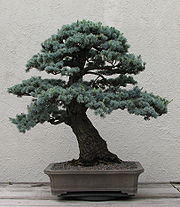 This private/public collaboration between the Foundation and the Arboretum enables the Museum to promote the art of bonsai and penjing to visitors through masterpiece displays and educational programs while also fostering intercultural friendship and understanding."
This private/public collaboration between the Foundation and the Arboretum enables the Museum to promote the art of bonsai and penjing to visitors through masterpiece displays and educational programs while also fostering intercultural friendship and understanding."
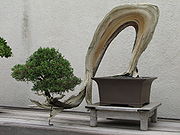 In 1976, the country of Japan
In 1976, the country of Japan
gave the country of The United States of America a gift of 53 Bonsai trees. The trees were selected by the Nippon Bonsai Association, with financial assistance from the Japan Foundation
. The trees arrived at the Potomac Bonsai Association, and volunteers worked with the staff of the US National Arboretum to keep the trees in display condition. In 1979, Janet Lanman talked with Dr. John Creech, Director of the Arboretum the possibility of adding American bonsai to the Museum. Dr. Creech proposed this idea to well known Bonsai teacher Marion Gyllenswan. An independent body of Bonsai authorities was assigned to review private Bonsai collections, possibly as a part of a national collection. These Bonsai authorities were called the National Bonsai Committee. In 1982, the National Bonsai Committee was reformed into the National Bonsai Foundation. The National Bonsai Foundation recruited people from all across the country to be directors. The members of the first Board were Marybel Balendonck, Larry Ragle, Melba Tucker, Frederic Ballard, and H. William Merritt. MaryAnn Orlando served as the Executive Director and principal fund raiser for the National Bonsai Foundation.
In 1986, the ten year anniversary of the gift from Japan, the National Bonsai Foundation announced that they would be building the American Bonsai Pavilion to compliment the Japanese Pavilion, and to showcase a collection of North American
Bonsai. This became a reality in 1990. On October 1, 1990 the American Bonsai Pavilion was dedicated to two American Bonsai Masters. The Yuji Yoshimura Educational Center is a work space, and a classroom. The John Y. Naka North American Pavilion provides the display area for the North American bonsai collection.
With donations from the Bonsai community, the National Bonsai and Penjing Museum grew greatly in the early 1990s. The Kaneshiro Tropical Conservatory (named for "Papa" Kaneshiro, the father of Hawaii
an Bonsai) was added for delicate trees. A behind the scenes greenhouse was also added for trees in development.
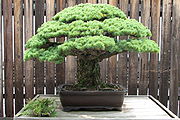 The National Bonsai and Penjing Museum has four collections. The Japanese, the Chinese, the North American, and the Viewing stone. In addition to the collections, it also has pavilions, courtyards, and gardens. The National Bonsai and Penjing Museum has a number of temporary exhibits going on at one time.
The National Bonsai and Penjing Museum has four collections. The Japanese, the Chinese, the North American, and the Viewing stone. In addition to the collections, it also has pavilions, courtyards, and gardens. The National Bonsai and Penjing Museum has a number of temporary exhibits going on at one time.
. These trees spent a year in quarantine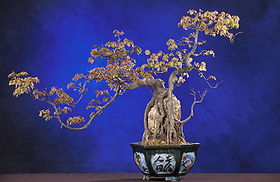 after arrival, and on July 19, 1976 were dedicated in a ceremony with many dignitaries from Japan, and the USA watching. Secretary of State
after arrival, and on July 19, 1976 were dedicated in a ceremony with many dignitaries from Japan, and the USA watching. Secretary of State
Henry Kissinger
acted for the American government, and accepted the trees. The collection which is now 63 trees can be seen in the Japanese Pavilion in April through October. From November to March, they can be seen in the Dr. Yee-sun Wu Chinese Pavilion.
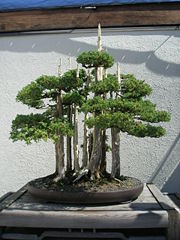 The Chinese
The Chinese
collection (also known as the Penjing collection) in the National Bonsai and Penjing Museum is in the Yee-sun Wu Chinese Garden Pavilion. This pavilion is named for Dr. Yee-sun Wu (1905-1995), who collected penjing in Hong Kong. In 1983, Janet Lanman, a NBF Board Member asked Dr. Wu if he would like to help include penjing in the Museum. Dr. Wu was delighted at the idea, and gave funding to build a pavilion, as well as donating many penjing trees. In 1988 the museum was renamed National Bonsai and Penjing Museum.
Collection are in the John Y. Naka North American Pavilion. The tropical species of this collection are in the Haruo Kaneshiro Tropical Conservatory. The 63 tree collection was made entirely by North Americans. The John Y. Naka North American Pavilion was dedicated in 1990 to John Y. Naka (1914-2004). His world famous Bonsai "Goshin
" (seen right) is displayed at the entrance to the Pavilion. The trees in this collection can be seen on display in spring, summer, and fall. In winter they are in the Chinese pavilion. the Haruo Kaneshiro Tropical Conservatory named for "Papa" Haruo Kaneshiro (the father of Hawaiian Bonsai) was completed in 1993.
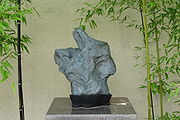
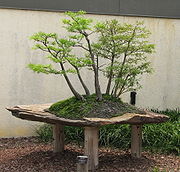 Besides having many beautiful Bonsai trees, the National Bonsai and Penjing Museum also has a world class collection of viewing stones. Bonsai and viewing stones are closely related. Both show great respect for nature, and when the small scale plants and stones are combined, the whole of nature can be imagined.
Besides having many beautiful Bonsai trees, the National Bonsai and Penjing Museum also has a world class collection of viewing stones. Bonsai and viewing stones are closely related. Both show great respect for nature, and when the small scale plants and stones are combined, the whole of nature can be imagined.
This collection began with six viewing stones that accompanied the 53 original Bonsai. The collection today has a total of 105 stones from all around the world. The stones can be seen in and around the Mary Mrose International Pavilion. The Melba Tucker Suiseki and Viewing Stone Display Area has its stones periodically changed in themes.
United States National Arboretum
The United States National Arboretum is an arboretum in Washington, D.C., operated by the United States Department of Agriculture's Agricultural Research Service as a division of the Henry A. Wallace Beltsville Agricultural Research Center...
show the arts of Bonsai
Bonsai
is a Japanese art form using miniature trees grown in containers. Similar practices exist in other cultures, including the Chinese tradition of penjing from which the art originated, and the miniature living landscapes of Vietnamese hòn non bộ...
, and Penjing
Penjing
Penjing , also known as penzai , tray landscape, potted scenery, potted landscape, and miniature trees and rockery is the ancient Chinese art of growing trees and plants, kept small by skilled pruning and formed to create an aesthetic shape and the complex illusion of age...
. The National Bonsai and Penjing Museum is located on the 446 acres (1.8 km²) campus of the US National Arboretum in Washington, D.C.
Washington, D.C.
Washington, D.C., formally the District of Columbia and commonly referred to as Washington, "the District", or simply D.C., is the capital of the United States. On July 16, 1790, the United States Congress approved the creation of a permanent national capital as permitted by the U.S. Constitution....
Each year over 200,000 people visit the museum.
Mission statement


History

Japan
Japan is an island nation in East Asia. Located in the Pacific Ocean, it lies to the east of the Sea of Japan, China, North Korea, South Korea and Russia, stretching from the Sea of Okhotsk in the north to the East China Sea and Taiwan in the south...
gave the country of The United States of America a gift of 53 Bonsai trees. The trees were selected by the Nippon Bonsai Association, with financial assistance from the Japan Foundation
Japan Foundation
The was established in 1972 by an Act of the Japanese Diet as a special legal entity to undertake international dissemination of Japanese culture, and became an independent administrative institution under the jurisdiction of the Foreign Ministry of Japan on 1 October 2003 under the "Independent...
. The trees arrived at the Potomac Bonsai Association, and volunteers worked with the staff of the US National Arboretum to keep the trees in display condition. In 1979, Janet Lanman talked with Dr. John Creech, Director of the Arboretum the possibility of adding American bonsai to the Museum. Dr. Creech proposed this idea to well known Bonsai teacher Marion Gyllenswan. An independent body of Bonsai authorities was assigned to review private Bonsai collections, possibly as a part of a national collection. These Bonsai authorities were called the National Bonsai Committee. In 1982, the National Bonsai Committee was reformed into the National Bonsai Foundation. The National Bonsai Foundation recruited people from all across the country to be directors. The members of the first Board were Marybel Balendonck, Larry Ragle, Melba Tucker, Frederic Ballard, and H. William Merritt. MaryAnn Orlando served as the Executive Director and principal fund raiser for the National Bonsai Foundation.
In 1986, the ten year anniversary of the gift from Japan, the National Bonsai Foundation announced that they would be building the American Bonsai Pavilion to compliment the Japanese Pavilion, and to showcase a collection of North American
North American
North American generally refers to an entity, people, group, or attribute of North America, especially of the United States and Canada together.-Culture:*North American English, a collective term used to describe American English and Canadian English...
Bonsai. This became a reality in 1990. On October 1, 1990 the American Bonsai Pavilion was dedicated to two American Bonsai Masters. The Yuji Yoshimura Educational Center is a work space, and a classroom. The John Y. Naka North American Pavilion provides the display area for the North American bonsai collection.
With donations from the Bonsai community, the National Bonsai and Penjing Museum grew greatly in the early 1990s. The Kaneshiro Tropical Conservatory (named for "Papa" Kaneshiro, the father of Hawaii
Hawaii
Hawaii is the newest of the 50 U.S. states , and is the only U.S. state made up entirely of islands. It is the northernmost island group in Polynesia, occupying most of an archipelago in the central Pacific Ocean, southwest of the continental United States, southeast of Japan, and northeast of...
an Bonsai) was added for delicate trees. A behind the scenes greenhouse was also added for trees in development.
Collections and exhibits

The Japanese Collection
This collection started with the 53 original trees from JapanJapan
Japan is an island nation in East Asia. Located in the Pacific Ocean, it lies to the east of the Sea of Japan, China, North Korea, South Korea and Russia, stretching from the Sea of Okhotsk in the north to the East China Sea and Taiwan in the south...
. These trees spent a year in quarantine

Secretary of State
Secretary of State or State Secretary is a commonly used title for a senior or mid-level post in governments around the world. The role varies between countries, and in some cases there are multiple Secretaries of State in the Government....
Henry Kissinger
Henry Kissinger
Heinz Alfred "Henry" Kissinger is a German-born American academic, political scientist, diplomat, and businessman. He is a recipient of the Nobel Peace Prize. He served as National Security Advisor and later concurrently as Secretary of State in the administrations of Presidents Richard Nixon and...
acted for the American government, and accepted the trees. The collection which is now 63 trees can be seen in the Japanese Pavilion in April through October. From November to March, they can be seen in the Dr. Yee-sun Wu Chinese Pavilion.
The Chinese Collection

China
Chinese civilization may refer to:* China for more general discussion of the country.* Chinese culture* Greater China, the transnational community of ethnic Chinese.* History of China* Sinosphere, the area historically affected by Chinese culture...
collection (also known as the Penjing collection) in the National Bonsai and Penjing Museum is in the Yee-sun Wu Chinese Garden Pavilion. This pavilion is named for Dr. Yee-sun Wu (1905-1995), who collected penjing in Hong Kong. In 1983, Janet Lanman, a NBF Board Member asked Dr. Wu if he would like to help include penjing in the Museum. Dr. Wu was delighted at the idea, and gave funding to build a pavilion, as well as donating many penjing trees. In 1988 the museum was renamed National Bonsai and Penjing Museum.
The North American Collection
Most of the trees in the North AmericanNorth American
North American generally refers to an entity, people, group, or attribute of North America, especially of the United States and Canada together.-Culture:*North American English, a collective term used to describe American English and Canadian English...
Collection are in the John Y. Naka North American Pavilion. The tropical species of this collection are in the Haruo Kaneshiro Tropical Conservatory. The 63 tree collection was made entirely by North Americans. The John Y. Naka North American Pavilion was dedicated in 1990 to John Y. Naka (1914-2004). His world famous Bonsai "Goshin
Goshin
Goshin is a bonsai created by John Y. Naka. It is a forest planting of eleven Foemina junipers , the earliest of which Naka began training into bonsai in 1948. Naka donated it to the National Bonsai Foundation in 1984, to be displayed at the United States National Arboretum; it has been there...
" (seen right) is displayed at the entrance to the Pavilion. The trees in this collection can be seen on display in spring, summer, and fall. In winter they are in the Chinese pavilion. the Haruo Kaneshiro Tropical Conservatory named for "Papa" Haruo Kaneshiro (the father of Hawaiian Bonsai) was completed in 1993.

The Viewing Stone Collection

This collection began with six viewing stones that accompanied the 53 original Bonsai. The collection today has a total of 105 stones from all around the world. The stones can be seen in and around the Mary Mrose International Pavilion. The Melba Tucker Suiseki and Viewing Stone Display Area has its stones periodically changed in themes.

